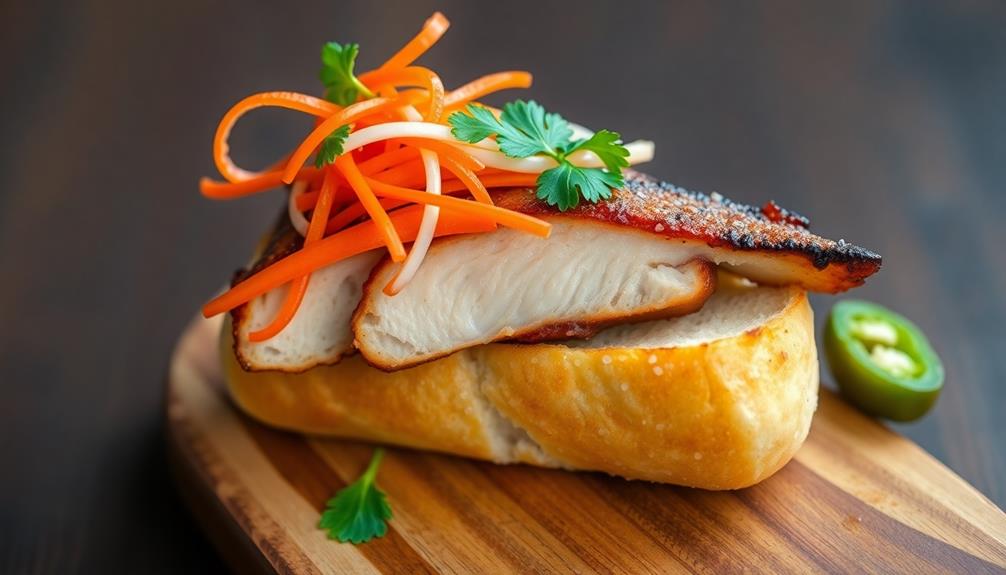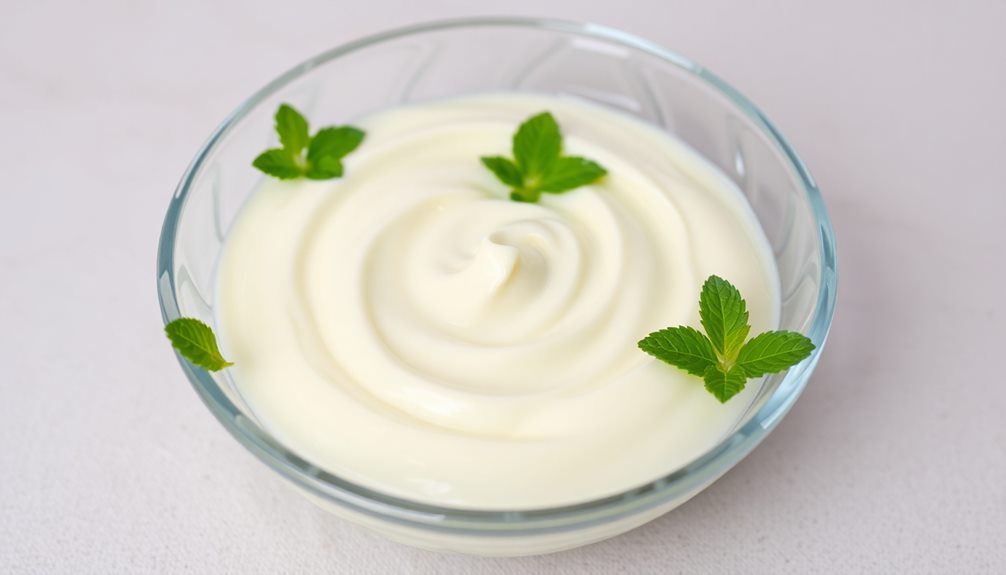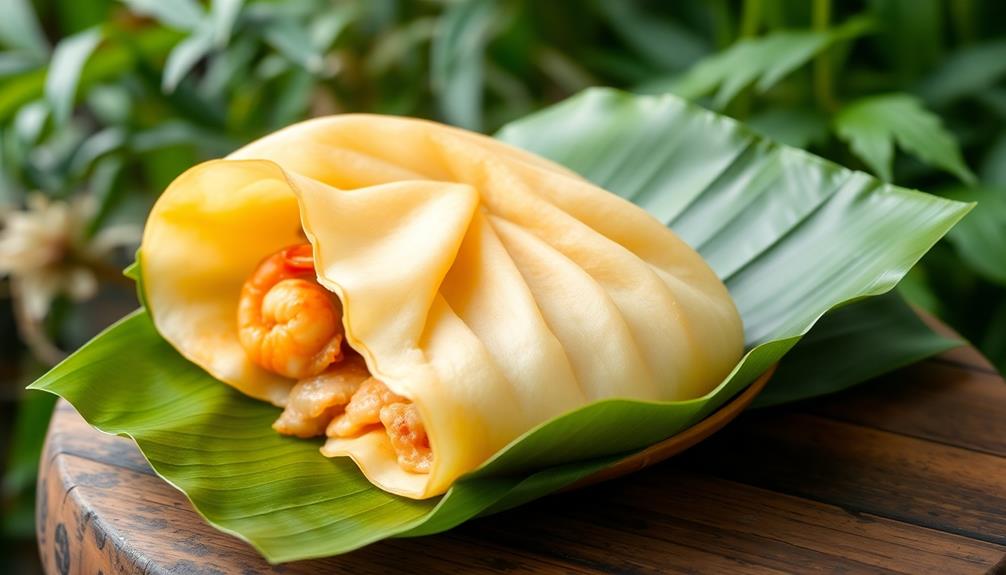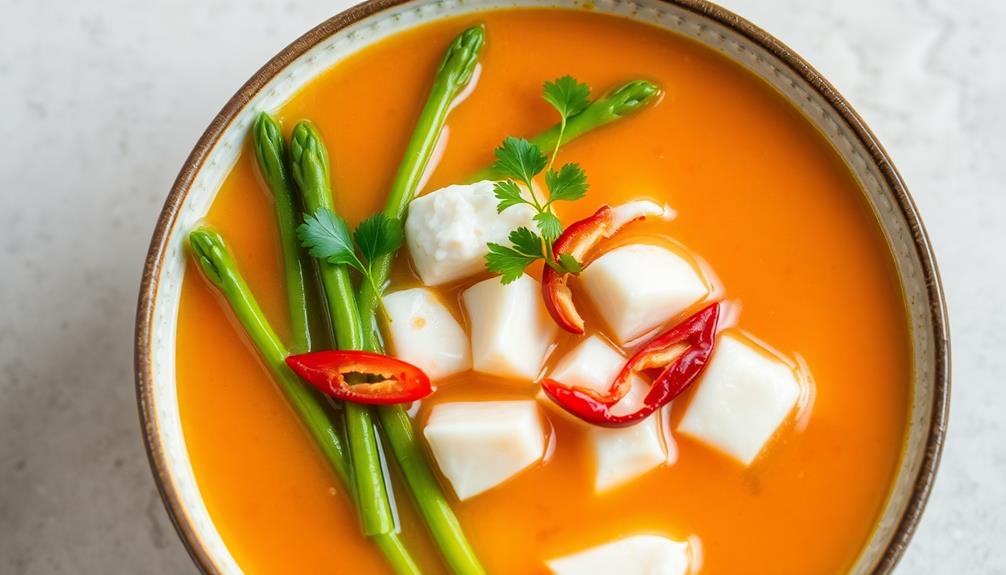Dive into the vibrant flavors of Vietnam with the iconic Banh Mi Thit Nuong! This savory sandwich blends the classic French baguette with tantalizing Vietnamese fillings. Savor the sweet, smoky grilled pork, crunchy pickled veggies, and fragrant herbs that create a harmonious dance on your taste buds. Craft this delectable dish by marinating the pork, pickling the veggies, and layering the components in a freshly toasted baguette. Top it off with a creamy dollop of mayo and a sprinkle of cilantro for a flavor-packed bite. Get ready to be transported to the bustling streets of Vietnam with every mouthful!
Key Takeaways
- Banh Mi Thit Nuong is a Vietnamese sandwich that combines the French baguette with savory grilled pork, pickled vegetables, and fragrant herbs.
- The dish represents a fusion of French and Vietnamese culinary traditions, reflecting the country's vibrant street food culture.
- The flavor profile of Banh Mi Thit Nuong balances sweet, savory, and tangy notes, with a variety of textures from the crunchy pickled veggies and soft baguette.
- Proper preparation techniques, such as marinating the pork and pickling the vegetables, are crucial to achieving the authentic taste and experience.
- Banh Mi Thit Nuong is a versatile dish that can be enjoyed as a quick meal, snack, or shared experience, often evoking feelings of nostalgia and satisfaction.
History

The origins of banh mi thit nuong, the iconic Vietnamese sandwich, can be traced back to the mid-20th century. During this time, French colonists brought their love for baguettes to Vietnam, where local cooks began experimenting with fillings.
The result was a fusion of French and Vietnamese flavors – a light and airy baguette stuffed with savory grilled pork, tangy pickled vegetables, and fragrant herbs. The dish was then elevated with a drizzle of spicy mayo and a touch of soy sauce, adding layers of complexity to each bite. This inventive interpretation of street food was reminiscent of the popular chapagetti fusion noodle recipe, where diverse ingredients come together in harmony. The contrast of textures and bold flavors made each mouthful an unforgettable experience.
As the sandwich gained popularity, each region of Vietnam put its own spin on the recipe. Some added creamy pâté, while others included spicy chili sauce.
Today, banh mi thit nuong is a beloved street food, with vendors across the country offering their own unique takes on this delicious Vietnamese classic.
Whether you're in Hanoi or Ho Chi Minh City, you'll find that every bite of this flavorful sandwich is a journey through Vietnam's rich culinary heritage.
Recipe
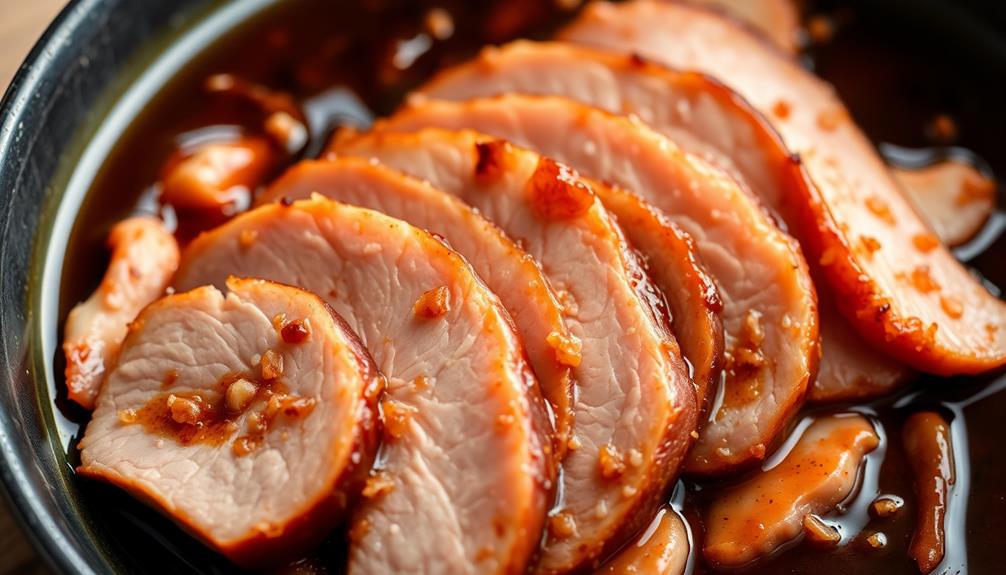
Banh Mi Thit Nuong is a quintessential Vietnamese sandwich that combines the flavors of sweet, savory, and tangy elements. The star of this dish is the grilled pork, which is marinated in a blend of aromatics and seasonings, lending it a depth of flavor that pairs perfectly with the crunchy, pickled vegetables and the soft, pillowy bread. The richness of the pork is complemented by the freshness of the vegetables, creating a delightful balance that's both satisfying and nutritious. Incorporating elements such as nutrition in raw summer squash can enhance the overall health benefits of your meal.
The key to a truly authentic Banh Mi Thit Nuong lies in the balance of textures and flavors. The crisp and refreshing pickled carrots and daikon, the rich and juicy grilled pork, and the airy and crusty Vietnamese-style baguette create a harmonious symphony of tastes and sensations.
- Pork loin, thinly sliced
- Soy sauce
- Brown sugar
- Fish sauce
- Garlic, minced
- Ginger, grated
- Lemongrass, finely chopped
- Carrots, julienned
- Daikon, julienned
- Rice vinegar
- Sugar
- Salt
- Vietnamese-style baguette or rolls
- Mayonnaise
- Cilantro, chopped
- Sliced cucumbers
- Sliced jalapeños (optional)
Marinate the pork in a mixture of soy sauce, brown sugar, fish sauce, garlic, ginger, and lemongrass for at least 30 minutes, or up to 4 hours. Grill or pan-fry the marinated pork until cooked through and slightly charred.
In a separate bowl, combine the julienned carrots and daikon with rice vinegar, sugar, and salt to make the pickled vegetables.
To assemble the Banh Mi, spread a generous amount of mayonnaise on the baguette or rolls, then layer the grilled pork, pickled vegetables, cilantro, sliced cucumbers, and jalapeños (if desired). Serve immediately while the bread is fresh and crisp.
For best results, use high-quality ingredients and pay attention to the balance of flavors and textures. The pickled vegetables can be made in advance to save time, and the pork can be grilled or pan-fried depending on your preference and cooking setup.
Cooking Steps
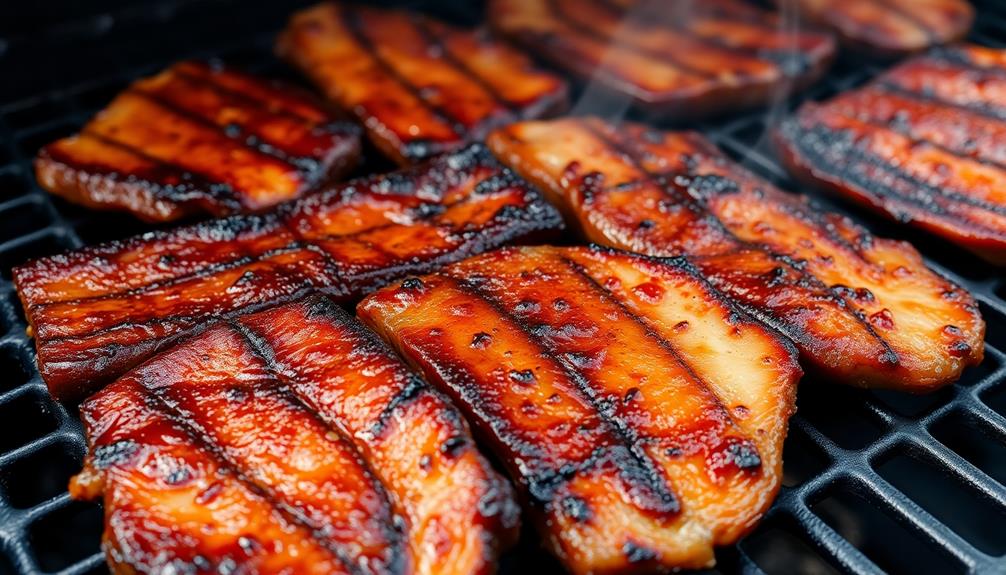
Grab your marinade ingredients and let's get started!
First, you'll marinate the pork in a blend of aromatic spices and flavors.
Next, prepare the pickled veggies that'll add the perfect crunchy contrast.
Then, fire up the grill and cook that meat to absolute perfection.
Step 1. Marinate Pork in Aromatics
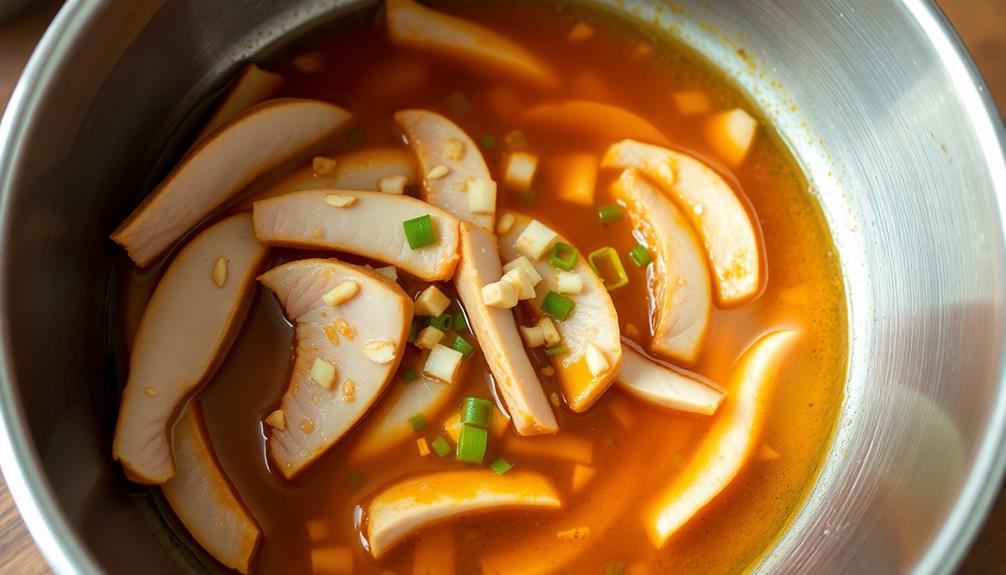
Marinating the pork in a fragrant blend of aromatics is the next crucial step in crafting an authentic banh mi thit nuong.
Start by combining soy sauce, brown sugar, garlic, and lemongrass in a large bowl. Toss the thinly sliced pork in this marinade, ensuring each piece is coated evenly.
Cover the bowl and let the pork soak up all those delicious flavors for at least 30 minutes, or up to 8 hours in the fridge. The longer you marinate, the more intense the flavor will be.
Be sure to stir the pork halfway through to distribute the marinade.
When you're ready to cook, remove the pork from the marinade and discard any leftover liquid. This prepares the meat for the next step – grilling to perfection!
Get ready for your taste buds to be tantalized by the mouthwatering aroma of the marinated pork as it sizzles on the grill.
Step 2. Prepare Pickled Vegetables
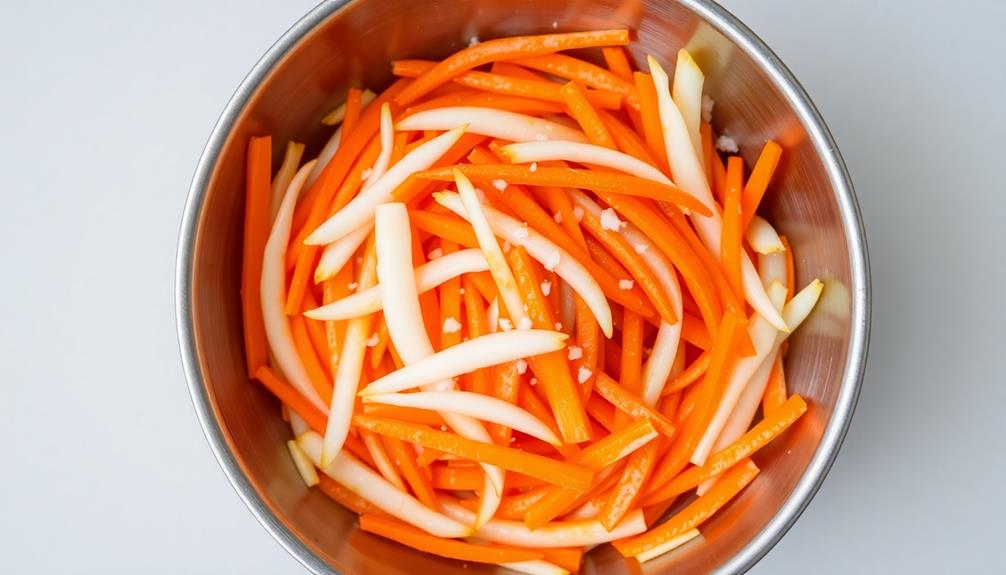
Now that you've marinated the pork to perfection, it's time to turn your attention to preparing the pickled vegetables. This quick and easy step adds a delightful crunch and bright flavor to your banh mi sandwich.
First, gather your veggies – carrots, daikon radish, and jalapeño (if you like a bit of heat). Slice them into thin, even strips using a sharp knife or mandoline slicer.
Next, place the veggies in a bowl and pour over a mixture of rice vinegar, sugar, and salt. Stir until the sugar and salt have dissolved.
Cover the bowl and refrigerate for at least 30 minutes, allowing the flavors to meld. The pickled veggies will become nicely crunchy and tangy, perfectly complementing the savory grilled pork.
When you're ready to assemble your banh mi, simply drain the pickled veggies and layer them onto your crusty baguette. Get ready for a burst of flavor in every bite!
Step 3. Grill Marinated Pork to Perfection

Grilling the marinated pork is the next step in creating an authentic banh mi sandwich. First, heat up your grill or grill pan to medium-high heat.
Once it's nice and hot, place the marinated pork slices onto the grates. Let them sizzle and caramelize, turning occasionally, until they're cooked through and slightly charred around the edges, about 3-5 minutes per side.
The key is to get that delicious grilled flavor that complements the tang of the pickled veggies. Be sure to baste the pork with any remaining marinade as it cooks, locking in all that mouthwatering flavor.
When the pork is done, transfer it to a cutting board and let it rest for a minute or two before slicing it into thin strips.
Now you're ready to assemble your banh mi with the grilled pork, pickled veggies, and all the other tasty toppings. Get ready for an explosion of Southeast Asian goodness in every bite!
Step 4. Assemble Sandwich With Prepared Components
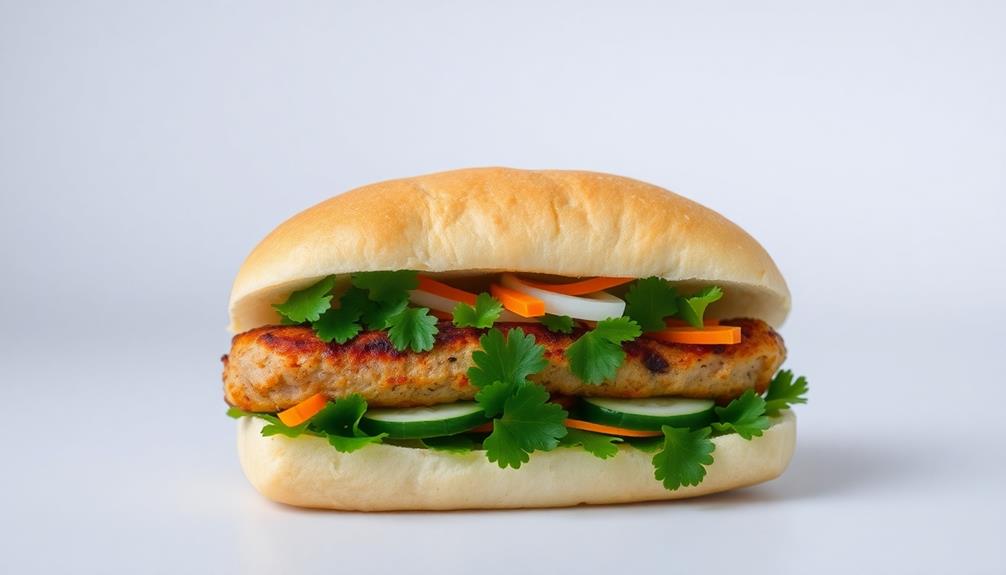
With the grilled pork ready, it's time to start assembling your banh mi sandwich.
First, take a crusty baguette and slice it in half lengthwise. Spread a generous layer of mayonnaise on the bottom half, then add a few slices of the juicy, flavor-packed pork.
Next, load up your sandwich with crisp, pickled veggies. Layer on the carrot and daikon slaw, followed by sliced cucumbers and jalapeños for a delightful crunch and heat.
Don't forget to include a few sprigs of fresh cilantro to really make those flavors pop!
Step 5. Garnish With Fresh Cilantro

The fresh cilantro will add a vibrant herbal note to your banh mi sandwich, reminiscent of the refreshing qualities found in herbal tea benefits.
Pluck the delicate leaves from the stems, allowing the fragrant aroma to fill the air. Sprinkle the cilantro generously over the assembled sandwich, making sure to cover every inch. The bright green leaves will provide a beautiful contrast to the savory meats and crunchy vegetables.
As you take your first bite, the cilantro will dance on your tongue, complementing the bold flavors of the banh mi.
The fresh, slightly peppery taste will cut through the richness of the pork, creating a harmonious balance. The cilantro will also add a refreshing element, helping to cleanse your palate between bites.
Final Thoughts
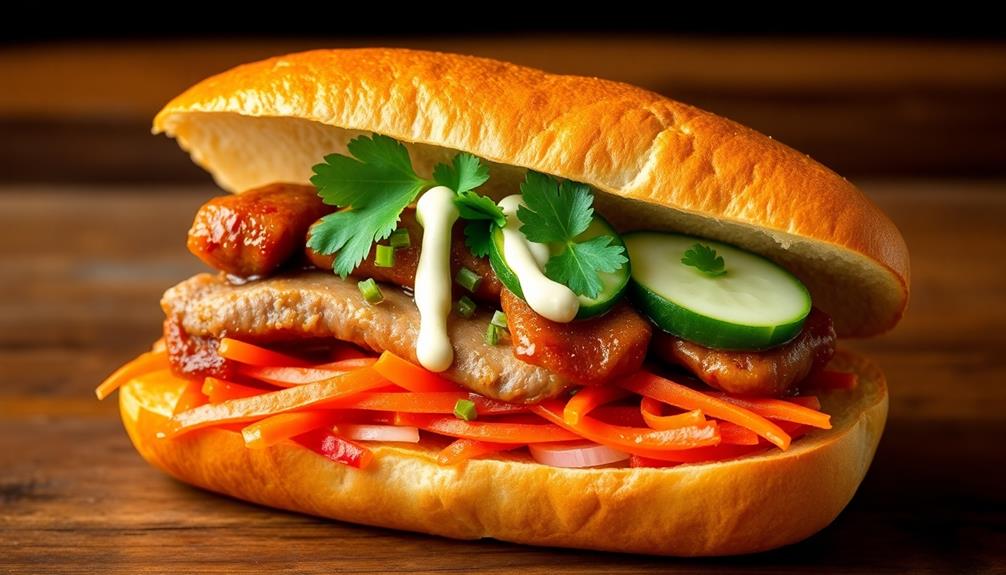
As you put the final touches on your freshly grilled banh mi, take a moment to savor the flavors that have come together in perfect harmony.
The tender, chargrilled pork, the crunch of the pickled carrots and daikon, the aromatic cilantro, and the tangy mayonnaise – each element has played its part in creating a symphony of tastes and textures.
This is a dish that celebrates the vibrant cultures and traditions of Vietnam, brought to life in your very own kitchen.
Whether you're sharing this culinary delight with loved ones or indulging in it solo, the experience is sure to leave you feeling satisfied and inspired.
As you take that first bite, let the flavors dance on your tongue, transporting you to the bustling streets of Saigon or the tranquil countryside.
Savor the moment, for this is more than just a sandwich – it's a taste of the rich tapestry that's Vietnamese cuisine.
Frequently Asked Questions
What Is the Typical Bread Used in Banh Mi Thit Nuong?
The typical bread used in banh mi thit nuong is a light and airy Vietnamese baguette. It's crisp on the outside, with a soft and fluffy interior that perfectly complements the flavors of the grilled pork filling.
How Long Can the Pickled Vegetables Be Stored?
The pickled vegetables can be stored for up to 2 weeks in the refrigerator. They'll keep their crunch and flavor if you store them in an airtight container. Just be sure to give them a good shake before using.
Can I Substitute Any Protein for the Grilled Pork?
You can absolutely substitute any protein for the grilled pork in this recipe. Try chicken, beef, or even tofu – the pickled veggies and other flavors will complement whatever protein you choose.
What Are Some Common Condiments Served With Banh Mi Thit Nuong?
You can add some common condiments to your banh mi thit nuong like pickled daikon and carrots, fresh cilantro, sliced cucumbers, and a flavorful sauce like nuoc cham or sriracha to complement the grilled pork.
Is It Possible to Make the Recipe Gluten-Free?
You can absolutely make the banh mi thit nuong recipe gluten-free. Simply swap the traditional baguette for a gluten-free bread or roll, and ensure all the other ingredients are also gluten-free. This will allow you to enjoy the same great flavors without the gluten.
